Just over two weeks ago I was writing this blog hunched up in a mountain tent, having not washed for a week, and with the company of just 7 other people. Now as I write I am sitting in the back of the survey aircraft, occasionally pausing to check readouts on the two laptops beside me, much like any other survey flight, but our destination, South Pole Station, couldn’t be more different to the remote field camps of the first three weeks of the PolarGAP survey.
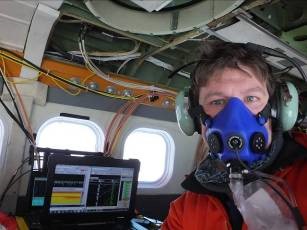
Tom Jordan flying on oxygen, with laptops monitoring the live stream of geophysical data. (BAS)
After our early Christmas celebration and completing the survey flying from the FD83 camp I got to experience a classic Antarctic event, waiting for weather to improve. In the end it took three days before our new camp close to Thiel Mountains could be put in on the ice sheet ~1000 km grid south west from FD83. This was a great Christmas present, but meant that 25th December wasn’t a day of rest, rather as soon as the call came in over the satellite phone that the camp was ready the survey aircraft set off for a four hour transit to the new camp with Carl the survey engineer and the two survey pilots on board.
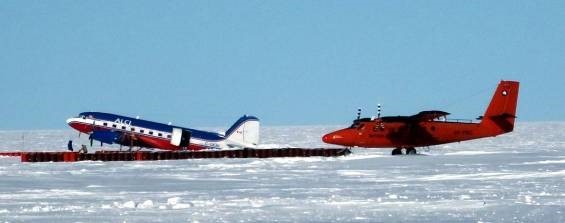
Basler and BAS utility twin otter together at the FD83 field camp. (BAS)
Unfortunately just after the survey aircraft made it into the Thiel Mountains camp the cloud rolled in leaving Mike, Arne and I stranded at FD83 with the crew of the utility aircraft tasked to move us across to the Thiel Mountains camp. We therefore got to experience Christmas and another couple of days of hospitality at the FD83 camp with Kenny and Harvey. There was plenty of good food to eat, but it was frustrating knowing the survey was continuing without us, with only limited supplies and infrastructure. Finally on the 27th the weather was good enough for the utility aircraft to fly us across to Thiel Mountains, and at the same time a Basler aircraft came up from Troll station to take our friends and colleagues from NPI back towards the coast along with all the camp infrastructure we had relied on for the last week or so.
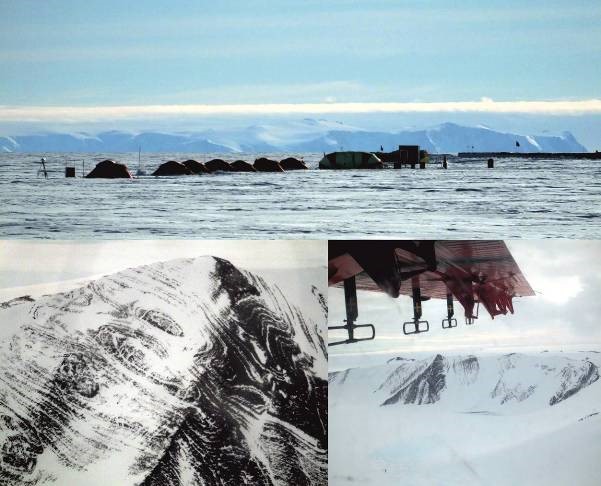
Thiel camp with the mountains in the background. Close up the mountains show spectacular folded layers of rock, while radar antennas beneath the aircraft wing measure the thickness of the ice around the mountains. (BAS)
Although the Thiel Mountains camp was even further south than FD83, at around 1000 m lower altitude the temperature when we arrived was a balmy -15°C, compared to ~-27°C at FD83. Aside from the warmer temperatures one great feature of the Thiel Mountains camp was the mountains themselves. Despite being ~60 km away they gave a spectacular backdrop, and were a good contrast to the flat white horizon of FD83. These mountains also give important insights into the geology of the area showing how tectonic forces in the past have compressed and folded the rocks in some parts of Antarctica. By comparing the airborne geophysical data collected over these known structures with regions completely blanketed with ice we can start to infer the past pattern of tectonic activity across the ice covered continent.
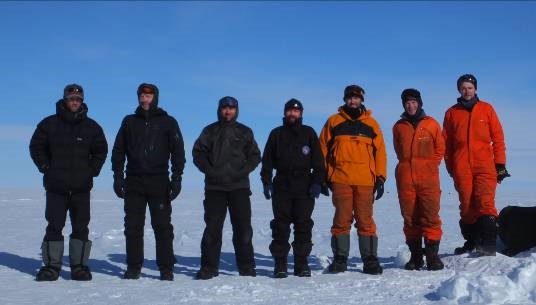
The PolarGAP team at Thiel Mountains; Ben, Arnie, Mike, Carl, Andy, Ian and Tom (me). (BAS)
The camp setup was similar to FD83 with a series of mountain tents for sleeping, and a communal dining and working tent. The main difference was the survey aircraft was actually parked in the camp between our sleeping and main eating and living tent. The camp was run by Ben, an experienced Alpine mountaineer and guide. Food was either chicken stew or curry, or sometimes individual dehydrated ration packs for dinner, pancakes or biscuits with cheese for lunch and cereal for breakfast. A sustaining diet, but not the most gourmet option.
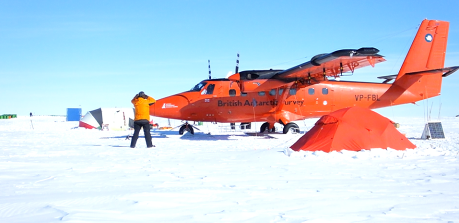
The survey aircraft was at the heart of the Thiels camp. (BAS)
When I arrived three flights had already been flown leaving only five more days of survey flying from Thiels camp. This included three shuttles to and from South Pole, with each leg lasting around 4 and a half hours making a very long working day, however, the survey progressed quickly, until we again ran into poor weather. This time although the camp was fine, almost continuous cloud cover over the Transantarctic Mountains made survey flying at our typical relatively low altitudes impossible. This wait was probably most frustrating for Ben with such spectacular mountains apparently so close, but with little to do but stay around the camp. After three days waiting the weather was good enough to attempt the final flight. However, ultimately cloud cover meant we had to fly up and over the clouds and mountains. To do this all on board had to wear oxygen masks for the highest part of the flight. This was not a pleasant experience, but it got the final mountain flight from the Thiel Mountains camp done, allowing us to move onto the final part of the PolarGAP adventure. Meanwhile Ben and Arnie departed back towards Rothera, setting up a camp for another BAS project on the Filchner Ice Shelf on the way.
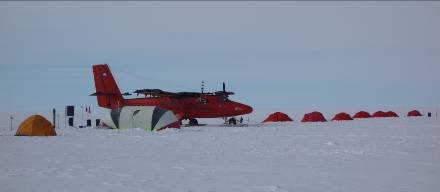
The Twin Otter survey aircraft at Thiels camp with the living tent in the background. Sleeping tents were laid out in a line running away from the camp. (Carl Robinson)
From Thiel Mountains we transited to South Pole station on the 6th January. The survey aircraft again collecting data as it transferred, so no possible scrap of survey flying time was wasted. This time the utility aircraft made the transfer flight on the same day so the entire survey team ended up at Pole together. On arrival at Pole from the field the first thing that struck me was the size of the place. Walking from my assigned room to the galley (dining room) to the science labs was probably further than the entire distance I walked on a normal day within either the Thiel or FD83 field camp, yet here it was all inside one building. The second thing to strike me on arrival at the Pole after the field was the number of people, with over 150 on base when we arrived it was a definite shock to the system after such a tiny community in the field. The final, and potentially most eagerly awaited novelty on arrival at Pole was having a shower. After three weeks in the field I felt it was best for all concerned if I slightly over-ran the allotted two minute maximum shower time.
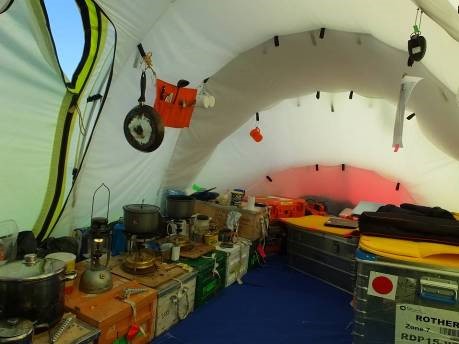
Inside the living tent cooking was one on two primus stoves, a paraffin lamp provided extra heat, and boxes of spare science equipment were the chairs. (BAS)
Here at Pole the facilities are excellent and all the staff keen to help in whatever way they can, from the people who fuel the aircraft working late to refuel us in the evening, to science support staff saving off data sets, or finding equipment to allow Carl to identify a fault with the radar system. The other scientists working here have also been keen to hear about our survey, and to show us some of the really exciting science that is happening here, from detecting neutrinos from black holes and observing distant galaxies, to recovering records of past climate fluctuations here on Earth.
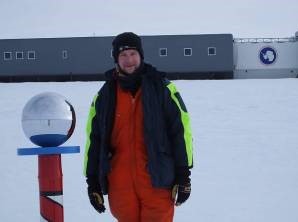
Tom Jordan at the South Pole, with the station in the background. (BAS)
We have completed several of our planned survey flights from South Pole already, and are now waiting on the weather to come good before we can complete our final flights. This includes changing the radar system on the survey aircraft to one which simulates a satellite system. Variations in observations from the space borne system suggest the ice crystals within the shallow snow layers may have an unusual structure due to the constant wind direction here on the Polar plateau. By flying a low altitude airborne survey with a similar system we can test this hypothesis. Rene Forsberg, one of the Principle Investigators of the PolarGAP project has joined us here at South Pole to run this snow radar system, and will also be carrying out the critical land gravity observations which will help tie the PolarGAP survey into the global gravity model.
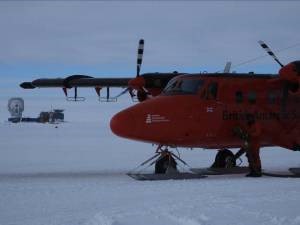
Pilot Ian Potten refuels the aircraft. (BAS)
One highlight of our stay at Pole so far has been a visit to the tunnels beneath the station. These are used primarily for water extraction, but also house the South Pole Gravity Station. This is a point where over the years many different scientists have come and made gravity measurements. The absolute gravity value of this point is therefore well known. Comparing measurements made here, and beside the survey aircraft will help tie our airborne gravity measurements precisely into the global model of the Earth’s gravitational field. The tunnels are also one of the spookiest and most atmospheric places I have ever visited, a real privilege to see.
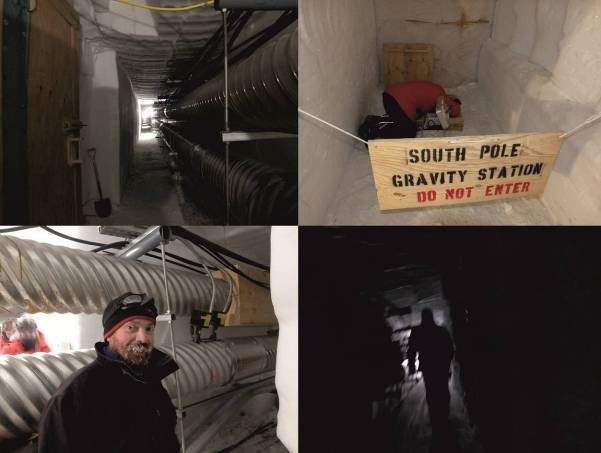
The tunnels beneath South Pole station – one of the spookiest places I have ever been. Rene Forsberg taking a measurement at the South Pole Gravity station. At a constant -47°C even with no wind ice forms on any surface, even Carl’s beard. Finally, if you look back you may see an unknown stranger. (BAS)
Editor’s note: low bandwidth affects the quality of pictures that Tom can send back from the field. We do hope you enjoy them anyway!
Post from Tom Jordan on 18 January 2016 (British Antarctic Survey)
About PolarGAP:
The main aim of ESA-funded project is to collect gravity data, completing a global model of the Earth’s gravity field which, away from the poles, is derived from satellite observations such as ESA’s GOCE. The project will also make measurements of ice thickness and the Earth’s magnetic field to reveal the mountains and valleys under the ice, and the geological processes which created them. For more information see the project page.








Discussion: no comments